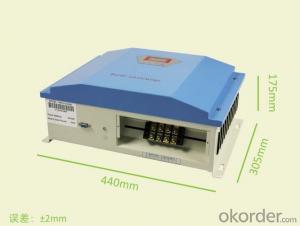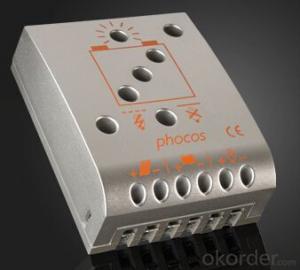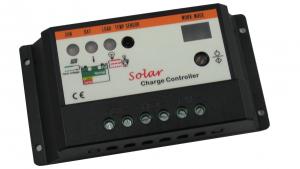American Made Solar Charge Controllers:5kW MPPT Charging Function
- Loading Port:
- Shanghai
- Payment Terms:
- TT or LC
- Min Order Qty:
- 1 unit
- Supply Capability:
- 10000 unit/month
OKorder Service Pledge
OKorder Financial Service
You Might Also Like
I. PRODUCT INTRODUCTION
Solar controller is control device which can control solar panel and transform solar energy into electricity then store to the battery bank. Solar controller is the most important part in off-grid system, whose performance has much effect on life expectancy and operation of the whole system, especially the battery expectancy. Or battery service life will be shortened by over charge or over discharge.
II. PERFORMANCE FEATURES
Superior military-grade components to ensure the product stability.
Perfect protection function, thus the system has higher reliability.
Check and set all operation parameters as requirement from LCD display.
PWM stepless unload mode, which burn the excess power into Dump load, making the battery charging in best status.
III. APPLICATION AREAS
Standalone Photovoltaic power station
Standalone Domestic household photovoltaic power system
Mobil communication base stations, expressway and other non-residential regions.
Coastal islands, remote mountainous, border posts for regions shortage of or without electricity.
Government demonstration projects, landscape lighting project etc.
IV. 5KW TECHNICAL PARAMETERS
Product Model | WS50-48-N00 | WS50-96-N00 | WS50-120-N00 | WS50-220-N00 | WS50-240-N00 |
Rated battery power | 48V | 96V | 120V | 220V | 240V |
Rated solar input power | 5kW | 5kW | 5kW | 5kW | 5kW |
Floating charge voltage | 58V | 116V | 145V | 266V | 290V |
Max Open Circuit Voltage | 100V | 200V | 250V | 458V | 500V |
Dimensions (L x W x H) | 442×307×172 mm | ||||
Net Weight | 8kg | ||||
Display mode | LCD | ||||
Cooling | Fan | ||||
Protection Level | IP20(Indoor) | ||||
Quiescent current | ≤20 mA | ||||
Protection functions | Battery over charge; battery anti-reverse-connection; solar reverse charge protection; solar anti-reverse-connection; lightning protection. | ||||
Ambient temperature | -20~+55℃ | ||||
Ambient humidity | 0~93%,without condensing | ||||
Working altitude | ≤4000m | ||||
In order to serve our customers better, our company can adjust parameter configuration according to customer’s requirement. | |||||

- Q: What is the maximum cable size that can be used between the solar panels and the solar controller?
- The maximum cable size that can be used between the solar panels and the solar controller depends on various factors such as the distance between the panels and the controller, the current carrying capacity of the cable, and the voltage drop allowed. It is advisable to consult the manufacturer's specifications or a professional installer to determine the appropriate cable size for optimal performance and safety.
- Q: Can a solar controller be used with an inverter?
- Yes, a solar controller can be used with an inverter. The solar controller regulates the charging of batteries from the solar panels, while the inverter converts the DC power stored in the batteries into AC power for use in household appliances.
- Q: What is the maximum battery voltage for a solar controller?
- The maximum battery voltage for a solar controller typically depends on the specific model and manufacturer, but it is commonly around 12 to 48 volts.
- Q: Can a solar controller protect batteries from deep discharge?
- Yes, a solar controller can protect batteries from deep discharge. Solar controllers are designed to regulate the charging process of batteries connected to solar panels. They monitor the battery voltage and prevent it from dropping below a certain threshold, which helps to avoid deep discharge. By controlling the charging and discharging process, solar controllers can extend the lifespan of batteries and ensure their optimal performance.
- Q: Can a solar controller be used with solar panels of different wattage?
- Yes, a solar controller can be used with solar panels of different wattage. The main function of a solar controller is to regulate and optimize the charging of batteries from solar panels. It does not rely on the wattage of the panels but rather on the voltage and current they generate. As long as the voltage and current output of the solar panels falls within the acceptable range supported by the solar controller, it can be used with panels of different wattage.
- Q: Can a solar controller be used with a solar-powered healthcare facility?
- Yes, a solar controller can be used with a solar-powered healthcare facility. A solar controller is responsible for regulating and optimizing the charging process of solar panels, which can help maintain a consistent and efficient power supply to the facility. This is crucial for ensuring uninterrupted and reliable operation of medical equipment, lighting, and other essential systems in a healthcare facility.
- Q: Can a solar controller be used with solar-powered irrigation systems?
- Yes, a solar controller can be used with solar-powered irrigation systems. A solar controller helps regulate and optimize the performance of solar panels, batteries, and pumps in an irrigation system. It ensures proper charging and discharging of batteries, controls water flow, and monitors system performance, making it a crucial component for efficient operation of solar-powered irrigation systems.
- Q: Can a solar controller be used with solar panel arrays?
- Yes, a solar controller can be used with solar panel arrays. The solar controller regulates the charge going into the batteries, ensuring they are not overcharged or damaged. It also helps optimize the efficiency of the solar panel arrays by managing the power output.
- Q: Can a solar controller be used with a solar-powered wastewater treatment plant?
- Yes, a solar controller can be used with a solar-powered wastewater treatment plant. A solar controller helps regulate the flow of electricity from solar panels to the plant's equipment, ensuring optimal performance and preventing damage. It also manages the charging and discharging of batteries, allowing for energy storage and uninterrupted operation.
- Q: Can a solar controller be used with a solar-powered data center?
- Yes, a solar controller can be used with a solar-powered data center. A solar controller regulates the flow of electricity from the solar panels to the batteries, ensuring optimal charging and preventing overcharging. This is essential for maintaining a stable power supply in a solar-powered data center, as it helps regulate and manage the energy generated by the solar panels.
Send your message to us
American Made Solar Charge Controllers:5kW MPPT Charging Function
- Loading Port:
- Shanghai
- Payment Terms:
- TT or LC
- Min Order Qty:
- 1 unit
- Supply Capability:
- 10000 unit/month
OKorder Service Pledge
OKorder Financial Service
Similar products
Hot products
Hot Searches
Related keywords

























